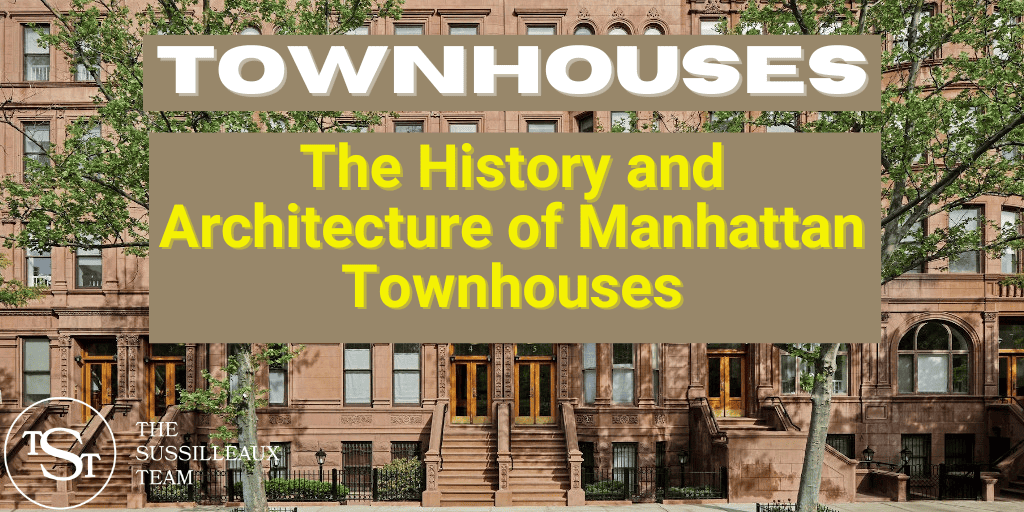What is the History and Architecture of Manhattan Townhouses?
The history and architecture of Manhattan townhouses date back to the 19th and early 20th centuries, showcasing diverse styles such as Greek Revival, Italianate, Second Empire, and Beaux-Arts. These townhouses reflect the city’s rich architectural heritage and offer a glimpse into the past.
A Primer of the History and Architecture of Manhattan Townhouses
Townhouses are a classic and enduring symbol of New York City’s architectural history. With their distinct facades, elegant interiors, and storied pasts, these residences have captivated the imaginations of architects, historians, and homeowners alike. In this article, we delve into the birth of Manhattan townhouses, their key architectural styles, and the iconic neighborhoods and examples that showcase their rich history and design.
I’ve been serving my client’s real estate needs for over 20 years. Along with my wife and business partner Dina, we are The Sussilleaux Team – a top tier real estate team specializing in townhouse sales.
Our clients take a great interest in the history and architectural nuances of townhouses. We put together this guide for them, and now we’re sharing it with you.
I have personally seen hundreds of townhouses and experienced all the eras, styles, and neighborhoods covered in this primer.
The Birth of Manhattan Townhouses
Dutch influences and early settlements
The origins of Manhattan townhouses can be traced back to the early Dutch settlements in the 17th century. Dutch settlers introduced the concept of row houses, which were single-family residences built side by side with shared walls. This space-efficient design allowed for a greater number of homes to be built in the limited space of Manhattan.
Development of the townhouse concept in New York
As New York City grew, so did the demand for housing. The townhouse evolved from the Dutch row house design, with each home taking on its own unique architectural style while maintaining the efficiency of shared walls. By the late 18th century, townhouses became the preferred housing choice for affluent New Yorkers, offering privacy, elegance, and status.
Key Periods in Manhattan Townhouse Architecture
Federal style (1780-1830)
The Federal style was the first major architectural style to emerge in Manhattan townhouses. Inspired by the British Georgian style, these townhouses featured symmetrical facades, simple ornamentation, and classic proportions. Key elements included red brick exteriors, fanlights above the entrance, and Palladian windows.
Greek Revival (1825-1860)
Greek Revival townhouses exuded grandeur and opulence, with design elements inspired by the temples of ancient Greece. These homes often featured massive columns, heavy cornices, and triangular pediments. Interiors boasted large entrance halls, marble fireplaces, and elaborate plasterwork.
Italianate (1840-1880)
The Italianate style emerged as a response to the rigid formality of Greek Revival architecture. These townhouses featured decorative cornices, tall, narrow windows, and cast-iron balconies. The style was heavily influenced by the romantic villas of Italy and often included ornate detailing and rounded arches.
Second Empire (1855-1885)
Second Empire townhouses were characterized by their mansard roofs, decorative ironwork, and elaborate ornamentation. This style, influenced by French architecture, was popular among New York’s elite and often featured spacious interiors with grand staircases and multiple fireplaces.
Neo-Grec (1865-1885)
The Neo-Grec style was a reinterpretation of the earlier Greek Revival, featuring more restrained and geometric designs. Key elements included incised ornamentation, square columns, and stylized floral motifs. These townhouses often had brownstone facades and simpler, more refined interiors.
Romanesque Revival (1880-1900)
Inspired by medieval European architecture, Romanesque Revival townhouses were characterized by their heavy masonry, rounded arches, and deeply recessed windows. These homes often featured asymmetrical facades, with intricate carvings and decorative stonework adding a sense of grandiosity.
Beaux-Arts (1885-1925)
The Beaux-Arts style represented the pinnacle of opulence and grandeur in Manhattan townhouses. These residences featured highly ornamented facades, classical columns, and lavish interiors with high ceilings and luxurious materials. The style was popular among the city’s elite and showcased their wealth and sophistication.
Iconic Manhattan Townhouse Districts and Notable Examples
Greenwich Village Historic District
Washington Square Park
Surrounding Washington Square Park, the Greenwich Village Historic District is a treasure trove of architectural gems, including many well-preserved townhouses. This area is known for its artistic and bohemian history, attracting writers, musicians, and artists who have made the Village their home.
Iconic townhouses and their architectural styles
Greenwich Village is home to a diverse array of architectural styles, including Federal, Greek Revival, and Italianate townhouses. Some notable examples include the row of Greek Revival homes on Washington Square North and the stunning Italianate townhouse at 18 West 10th Street, which was once the residence of author Mark Twain.
Upper East Side Historic District
Carnegie Hill neighborhood
The Carnegie Hill neighborhood on the Upper East Side is synonymous with elegance and sophistication. This area boasts some of the most exclusive and well-preserved townhouses in Manhattan, showcasing the architectural styles of the Gilded Age and beyond.
Key townhouses and their architectural significance
Some notable townhouses in the Carnegie Hill neighborhood include the Otto Kahn Mansion, a Beaux-Arts masterpiece on East 91st Street, and the Andrew Carnegie Mansion on Fifth Avenue, which now houses the Cooper Hewitt Smithsonian Design Museum. The neighborhood also features numerous Romanesque Revival and Neo-Grec townhouses, showcasing the architectural diversity of the area.
Upper West Side Historic District
Riverside Drive and West End Avenue
The Upper West Side Historic District is another area rich in architectural history, with Riverside Drive and West End Avenue boasting some of the finest examples of Manhattan townhouses. The tree-lined streets and proximity to Riverside Park add to the neighborhood’s charm and allure.
Noteworthy townhouses and their designs
A prime example of Romanesque Revival architecture can be found at 351 Riverside Drive, designed by renowned architect Clarence True. Additionally, the Upper West Side is home to many Beaux-Arts townhouses, such as the one at 330 West 72nd Street, featuring a limestone facade and ornate ironwork.
Architectural Elements and Features of Manhattan Townhouses
Exterior Design Elements
Facades and materials
Manhattan townhouses showcase a variety of facade materials, including brick, brownstone, limestone, and marble. The choice of material often reflects the architectural style of the home, with brownstone being popular for Neo-Grec townhouses and limestone used in Beaux-Arts designs.
Entrances and stoops
A defining feature of Manhattan townhouses is the entrance, often elevated by a stoop – a small set of stairs leading to the front door. Stoops serve both a practical and aesthetic purpose, providing an elegant entryway while separating the home from the bustling streets below.
Ironwork and railings
Ornate ironwork is a common feature of Manhattan townhouses, with decorative railings, balconies, and window guards adding to their charm. The design of the ironwork often reflects the architectural style of the townhouse, with elaborate patterns seen in Italianate and Beaux-Arts homes.
Windows and cornices
The windows and cornices of Manhattan townhouses contribute to their distinctive appearance. Architectural styles dictate the shape, size, and ornamentation of windows, while cornices – the decorative molding at the top of the building – provide a crowning touch.
Interior Design Elements
Layout and floorplans
Manhattan townhouses often feature a vertical layout, with multiple floors connected by a central staircase. Common floor plans include a parlor floor, where formal entertaining took place, and separate floors for bedrooms, kitchens, and staff quarters. Many modern townhouses have been adapted to include open-concept living spaces and additional amenities.
High ceilings and crown molding
High ceilings are a hallmark of Manhattan townhouses, providing a sense of grandeur and spaciousness. Crown molding, often adorned with intricate designs, adds elegance and sophistication to these homes.
Staircases and balustrades
The central staircase in a Manhattan townhouse is both a functional and decorative element, with elaborate balustrades and handrails showcasing the craftsmanship of the period. Staircases often feature carved newel posts and ornate iron or woodwork.
Fireplaces and mantels
Fireplaces are a common feature in Manhattan townhouses, often serving as a focal point in living and dining rooms. The design of the fireplace and mantel varies according to the architectural style, with marble, carved wood, and cast iron used to create unique and eye-catching centerpieces.
The Modern-Day Appeal of Manhattan Townhouses
Preserving Architectural Heritage
Landmark designation and historic districts
Many Manhattan townhouses have been granted landmark status, ensuring their architectural and historical significance is preserved. Historic districts, such as Greenwich Village and the Upper East Side, provide additional protection, ensuring that new developments and alterations are in keeping with the character of the neighborhood.
Restoration and renovation projects
The preservation and restoration of Manhattan townhouses require a delicate balance between maintaining their historic charm and updating them for modern living. Many homeowners undertake extensive renovation projects to preserve original features while adding contemporary amenities and design touches.
Contemporary Adaptations
Combining historic charm with modern amenities
Manhattan townhouses continue to be highly sought-after, as homeowners appreciate the combination of historic charm and modern conveniences. Renovated townhouses often feature state-of-the-art kitchens, luxurious bathrooms, and energy-efficient systems, while maintaining original architectural details.
Sustainable upgrades and eco-friendly solutions
As sustainability becomes increasingly important, many Manhattan townhouse owners are incorporating eco-friendly solutions into their renovations. Solar panels, energy-efficient appliances, and green roofing materials are just a few examples of sustainable upgrades that can be seamlessly integrated into these historic homes.
Conclusion
Manhattan townhouses represent a fascinating chapter in the architectural history of New York City, showcasing the evolution of design and the city’s growth. From their origins in the Dutch settlements to the opulence of the Gilded Age, these residences continue to captivate with their enduring charm and timeless elegance. The preservation and adaptation of Manhattan townhouses for modern living ensures that their architectural legacy will be enjoyed for generations to come.
What’s your favorite style? Your favorite neighborhood? For expert insights that delve deeper into these subjects, reach out to us and have a chat. We look forward to hearing from you. Reach out to Michael and Dina Sussilleaux
Further Reading
You can return to The Complete Guide to Manhattan Townhouses or read the next article in the series; Why Manhattan Townhouses are Highly Desirable Real Estate
Frequently Asked Questions (FAQs)
- What is the difference between a townhouse and a brownstone?
- How much does a Manhattan townhouse typically cost?
- What are some key preservation and restoration tips for Manhattan townhouse owners?
- How can you identify the architectural style of a Manhattan townhouse?
- Why are Manhattan townhouses considered valuable real estate investments?
What is the difference between a townhouse and a brownstone?
A townhouse is a term used to describe a multi-story, single-family residence that shares one or more walls with adjacent properties. It is a broader category that includes various architectural styles and building materials. On the other hand, a brownstone refers specifically to a type of townhouse built with brownstone, a type of sandstone that is brown in color. Brownstones are typically associated with historic neighborhoods in New York City, such as Brooklyn and Manhattan, and are known for their distinctive facades, stoops, and decorative details.
How much does a Manhattan townhouse typically cost?
Manhattan townhouses can vary significantly in price depending on factors such as location, size, architectural style, and condition. In general, townhouses in Manhattan are considered prime real estate and can range from a few million dollars for a smaller, less renovated property to tens of millions of dollars for a large, fully restored townhouse in a prestigious neighborhood. It’s important to note that the market is always changing, so it’s best to consult with a real estate professional for the most current and accurate pricing information.
What are some key preservation and restoration tips for Manhattan townhouse owners?
Preserving and restoring a Manhattan townhouse can be a complex and rewarding process. Some key tips include:
- Hiring experienced professionals, such as architects, contractors, and preservation consultants, who are familiar with historic properties and local regulations.
- Maintaining the original features and architectural details, such as crown molding, fireplaces, and staircases, whenever possible.
- Updating systems like plumbing, electrical, and HVAC to modern standards while preserving the historic character of the home.
- Choosing period-appropriate materials and finishes for any renovations or restorations.
- Obtaining necessary permits and approvals from local authorities and historic preservation boards before making changes to the property.
How can you identify the architectural style of a Manhattan townhouse?
Identifying the architectural style of a Manhattan townhouse involves examining both exterior and interior features. Some key elements to consider include the type of building materials used (e.g., brownstone, brick, limestone), the shape and design of windows, the style of the entrance and stoop, and any ornamental details such as ironwork, cornices, and decorative molding. Familiarizing yourself with common architectural styles in Manhattan, such as Federal, Greek Revival, Italianate, and Beaux-Arts, can also be helpful in identifying the style of a particular townhouse.
Why are Manhattan townhouses considered valuable real estate investments?
Manhattan townhouses are considered valuable real estate investments for several reasons. First, they are often located in prestigious neighborhoods and historic districts, which typically retain their value or appreciate over time. Second, townhouses offer a unique combination of historic charm, architectural significance, and modern amenities, which appeal to a wide range of buyers. Third, they often provide more living space and privacy than apartments or condos, making them a desirable option for families or those seeking a more traditional living arrangement. Finally, owning a piece of Manhattan’s architectural history can be both a personal and financial reward for those who appreciate the city’s rich heritage.





